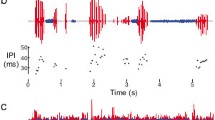Abstract
Mutations at theperiod (per) locus inDrosophila melanogaster alter rhythmic components of the male courtship song. We have examined the mating speed of females homozygous for mutantper alleles when presented with artificial mutant songs. Mutant females retain a preference for wild-type over mutant songs, thus male song and female preference are probably under separate genetic control. In contrast,per-mutant females from an established laboratory stock which had been maintained for nearly two decades appear to have an enhanced response to the corresponding mutant song in that they no longer discriminate against mutant song. These results are discussed in terms of the “genetic coupling” and “coevolution” theories of complementarity between male and female components of communication systems.
Similar content being viewed by others
References
Alexander, B. D. (1962). Evolutionary change in cricket acoustic communication.Evolution 16:443–467.
Baylies, M. K., Bargiello, T. A., Jackson, F. R., and Young, M. W. (1987). Changes in abundance or structure of theper gene product can alter periodicity of theDrosophila clock.Nature 326:390–392.
Boake, C. R. B. (1991). Coevolution of senders and receivers of sexual signals.Trends Ecol. Evol. 6:225–227.
Butlin, R. K., and Ritchie, M. G. (1989). Genetic coupling in mate recognition systems: What is the evidence?Biol. J. Linn. Soc. 37:237–246.
Doherty, J. A., and Gerhardt, H. C. (1984). Acoustic communication of hybrid tree frogs: Sound production by males and selective phonotaxis by females.J. Comp. Physiol. A 154:319–330.
Greenacre, M. L. (1990).Genetic Analysis of Courtship Behaviour and Biological Rhythms in Drosophila; Ph.D. thesis, University of Leicester, Leicester.
Hamblen, M., Zehring, W. A., Kyriacou, C. P., Reddy, P., Yu, Q., Wheeler, D. A., Zwiebel, L. J., Konopka, R. J., Rosbash, M., and Hall, J. C. (1986). Germ-like transformation involving DNA from theperiod locus inDrosophila melanogaster. Overlapping genomic fragments that restore circadian and ultradian rhythmicity toper 0 andper − mutants.J. Neurogenet. 3:249–291.
Hoy, R. R. (1974). Genetic control of acoustic behaviour in crickets.Am. Zool. 14:1067–1080.
Hoy, R. R., Hahn, J., and Paul, R. C. (1977). Hybrid cricket auditory behaviour: Evidence for genetic coupling in animal communication.Science 195:82–84.
Konopka, R. J., and Benzer, S. (1971). Clock mutants ofDrosophila melanogaster.Proc. Natl. Acad. Sci. USA 68:2112–2116.
Kirkpatrick, M., and Ryan, M. J. (1991). The evolution of mating preferences and the paradox of the lek.Nature 350:33–38.
Kyriacou, C. P., and Hall, J. C. (1980). Circadian rhythm mutations inDrosophila affect short-term fluctuations in the male's courtship song.Proc. Natl. Acad. Sci. USA 77:6929–6233.
Kyriacou, C. P., and Hall, J. C. (1982). The function of courtship song rhythms inDrosophila.Anim. Behav. 30:794–801.
Kyriacou, C. P., and Hall, J. C. (1984). Learning and memory mutations impair acoustic priming of mating behaviour inDrosophila.Nature 308:62–65.
Kyriacou, C. P., and Hall, J. C. (1985). Action potential mutations stop a biological clock inDrosophila.Nature 314:171–173.
Kyriacou, C. P., and Hall, J. C. (1986). Inter-specific genetic control of courtship song production and reception inDrosophila.Science 232:494–497.
Kyriacou, C. P., and Hall, J. C. (1989). Spectral analysis ofDrosophila courtship song rhythms.Anim. Behav. 37:850–859.
Kyriacou, C. P., Oldroyd, M., Wood, J., Sharp, M., and Hill, M. (1990). Clock mutations alter developmental timing inDrosophila.Heredity 64:395–401.
Lande, R. (1981). Models of speciation by sexual selection on polygenic traits.Proc. Natl. Acad. Sci. USA 78:3721–3725.
Lofstedt, C., Hansson, B. S., Roelofs, W., and Bengtsson, B. O. (1989). No linkage between genes controlling female pheromone production and male pheromone response in the European corn borer,Ostrinia nubilalis Hubner (Lepidoptera; Pyralidae).Genetics 123:553–556.
Ryan, M. J., Fox, J. H., Wilczynski, W., and Rand, A. S. (1990). Sexual selection for sensory exploitation in the frogPhysalaemus pustulosis.Nature 343:66–67.
Shorey, H. H. (1962). The nature of the sound produced byDrosophila melanogaster during courtship.Science 137:677–678.
Von Helversen, D., and Von Helverson, O. (1975a). Verhaltensgenetische untersuchungen am akustischen kommunikationssystem der feldheuschrecken (Orthoptera: Acrididae). I. Der Gesang von artbastarden zwischenChorthippus biguttulus undCh. mollis.J. Comp. Physiol. 104:273–299.
Von Helversen, D., and Von Helverson, O. (1975b). Verhaltensgenetische untersuchungen am akustischen kommunikationssystem der feldheuschrecken (Orthoptera: Acrididae). II. Das lautschema von artbastarden zwischenChorthippus biguttulus undCh. mollis.J. Comp. Physiol. 104:301–323.
Wheeler, D. A., Kyriacou, C. P., Greenacre, M. L., Yu, Q., Rutila, J. E., Rosbash, M., and Hall, J. C. (1991). Molecular transfer of a species-specific courtship behaviour fromDrosophila simulans toDrosophila melanogaster.Science 251:1082–1085.
Winer, B. J. (1962).Statistical Principles in Experimental Design, McGraw-Hill, Tokyo, Sect. 7.2.
Yu, Q., Jacquier, A. C., Citri, Y., and Colot, H. M. (1987). Molecular mapping of point mutations in theperiod gene that stop or speed up biological clocks inDrosophila melanogaster.Proc. Natl. Acad. Sci. USA 84:784–788.
Zouros, E. (1981). The chromosomal basis of sexual isolation in two sibling species ofDrosophila: D. artizonensis andD. mojavensis.Genetics 97:703.
Author information
Authors and Affiliations
Rights and permissions
About this article
Cite this article
Greenacre, M.L., Ritchie, M.G., Byrne, B.C. et al. Female song preference and theperiod gene inDrosophila . Behav Genet 23, 85–90 (1993). https://doi.org/10.1007/BF01067557
Received:
Accepted:
Issue Date:
DOI: https://doi.org/10.1007/BF01067557




